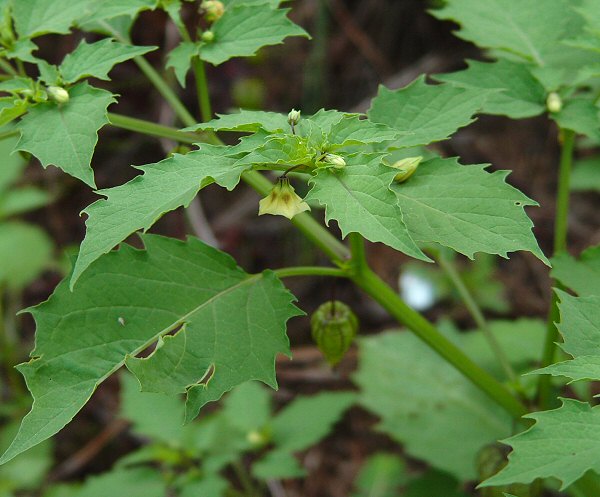Physalis angulata L.
Cutleaf Ground Cherry

Native
CC = 3
CW = 3
MOC = 32
© DETenaglia
Physalis angulata L.Cutleaf Ground Cherry | |
 |
Native CC = 3 CW = 3 MOC = 32 |
© DETenaglia |
|
Family - Solanaceae Habit - Taprooted annual forb.
Stem - Ascending, to 80 cm, usually with several spreading to ascending branches, stout, glabrous or sparsely pubescent toward the tip with short, antrorse, nonglandular hairs 0.1-0.5 mm long.
Leaves - Alternate, simple, petiolate. Blades 2-12 cm long, lanceolate to ovate, tapered to a sharply pointed tip, rounded to angled or tapered at the base, the margins relatively sparsely and irregularly toothed (with 2-9 teeth along each side), minutely nonglandular-hairy, the teeth mostly sharply pointed, irregularly shallow and broad, the surfaces green when fresh, drying uniformly green, glabrous or sparsely pubescent with minute, appressed, nonglandular, hairs.
Inflorescences - Solitary axillary flowers, the stalks 7-17 mm long becoming elongated to 15-30 mm at fruiting.
Flowers - Actinomorphic, hypogynous, perfect, usually nodding. Calyces 3-5 mm long at flowering, the lobes 1-3 mm long, the outer surface glabrous or sparsely pubescent with minute nonglandular hairs (these denser along the lobe margins) at flowering, glabrous or sparsely hairy along the main veins at fruiting, at fruiting becoming elongated to 20-40 mm long, shallowly 10-ribbed, rounded to very shallowly concave at the base, mostly remaining green, occasionally yellow to tan with age. Corollas 6-10 mm long, uniformly light yellow to lemon yellow, the inner surface occasionally slightly purplish-tinged toward the base. Stamens with slender filaments half as wide as the anthers or narrower, the anthers 1-3 mm long, blue or bluish-tinged, arched but not coiled after dehiscence.
Fruits - Juicy berries 1.0-1.5 cm long, green or yellow to orangish yellow. Seeds numerous, 1.5-2.5 mm in longest dimension, asymmetrically ovate, flattened, the surface minutely pitted, somewhat shiny, light yellow or yellowish brown.
Flowering - May - September. Habitat - Streambanks, sloughs, pond margins, moist depressions, crop field margins, railroads, moist disturbed areas. Origin - Native to the U.S. Lookalikes - Numerous other species of Physalis, especially P. acutifolia and P. missouriensis. Other info. - This species of ground cherry is found in scattered counties in Missouri, predominantly south of the Missouri River. It seems to have a particular affinity for crop field margins. Missouri is near the northern edge of the plant's natural North American distribution, which extends southward as far as South America. In the continental U.S. it is found across the southern half of the country. Photographs taken off Lee Rd 54, Lee County, AL., 8-26-04 (DETenaglia); also along the Katy Trail near Dutzow, Warren County, MO, 8-2-2012, near East Central College in Union, Franklin County, MO, 10-8-2014, and along a roadside west of Duck Creek Conservation Area, Wayne County, MO, 10-12-2021 (SRTurner). |